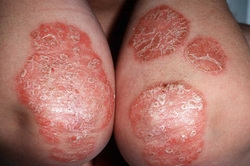|
|
Pathology definition - Psoriasis

Psoriasis
Psoriasis is a dermatological condition which characterized by the present of red scaly raised plaque type lesion which commonly present on the extensor surface of the body such as the elbow, knee or the scalp. Plaque type of lesion will bleed if the scaly plaque is removed. This is known as positive Auspitz sign.
Psoriasis has a strong association with joint disorder and is known as psoriatic arthritis. Besides that patient who suffer from psoriasis may also complain of onycholysis which is the separation of the nail plate from the nail bed. Other minor association may include myopathy or enteropathy ( inflammation of the intestine).
The treatment of psoriasis include, UVB light therapy, methotrexate, topical corticosteroid and tar therapy.
Psoriasis is part of autoimmune disorder. Psoriasis may cause thickening of the epidermis ( acanthosis),cluster of the neutrophils in epidermis ( spongiform pustules), increased the proximity of the blood vessel in the dermis to the surface of the skin, cluster of neutrophils in the stratum corneum ( Munro micro abscesses) as well as parakeratosis with thinning of the stratum granulosum.
References
1.Farber, E M, and L Nall. “Childhood Psoriasis.” Cutis 64, no. 5 (November 1999): 309–314.
2.Jiaravuthisan, Michael M., Denis Sasseville, Ronald B. Vender, Francis Murphy, and Channy Y. Muhn. “Psoriasis of the Nail: Anatomy, Pathology, Clinical Presentation, and a Review of the Literature on Therapy.” Journal of the American Academy of Dermatology 57, no. 1 (July 2007): 1–27. doi:10.1016/j.jaad.2005.07.073.
3.G, De Rosa, and Mignogna C. “The Histopathology of Psoriasis.” Reumatismo 59 Suppl 1 (December 2006): 46–48.
Psoriasis is a dermatological condition which characterized by the present of red scaly raised plaque type lesion which commonly present on the extensor surface of the body such as the elbow, knee or the scalp. Plaque type of lesion will bleed if the scaly plaque is removed. This is known as positive Auspitz sign.
Psoriasis has a strong association with joint disorder and is known as psoriatic arthritis. Besides that patient who suffer from psoriasis may also complain of onycholysis which is the separation of the nail plate from the nail bed. Other minor association may include myopathy or enteropathy ( inflammation of the intestine).
The treatment of psoriasis include, UVB light therapy, methotrexate, topical corticosteroid and tar therapy.
Psoriasis is part of autoimmune disorder. Psoriasis may cause thickening of the epidermis ( acanthosis),cluster of the neutrophils in epidermis ( spongiform pustules), increased the proximity of the blood vessel in the dermis to the surface of the skin, cluster of neutrophils in the stratum corneum ( Munro micro abscesses) as well as parakeratosis with thinning of the stratum granulosum.
References
1.Farber, E M, and L Nall. “Childhood Psoriasis.” Cutis 64, no. 5 (November 1999): 309–314.
2.Jiaravuthisan, Michael M., Denis Sasseville, Ronald B. Vender, Francis Murphy, and Channy Y. Muhn. “Psoriasis of the Nail: Anatomy, Pathology, Clinical Presentation, and a Review of the Literature on Therapy.” Journal of the American Academy of Dermatology 57, no. 1 (July 2007): 1–27. doi:10.1016/j.jaad.2005.07.073.
3.G, De Rosa, and Mignogna C. “The Histopathology of Psoriasis.” Reumatismo 59 Suppl 1 (December 2006): 46–48.
